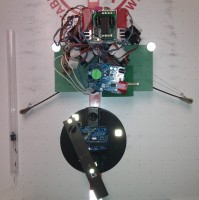
This work extends dynamic robotic legged locomotion from horizontal motions such as walking, hopping, and running, to vertical motions such as leaping maneuvers. We propose a few mechanism to achieve such motion. We are inspired by parkour! We try to use only frictional contact with the environment and not use spines, magnets, etc. By using dynamics to our advantage we can stay in contact with the wall and “kick” ourself toward the other wall.
So far we have three prototypes: DSAC, DTAR and the ParkourBot. The DSAC — Dynamic, Single Actuated Climber, propels itself upwards by oscillating its leg in a symmetric fashion using a single actuator. This mechanism achieves dynamic, vertical motion while retaining simplicity in design and control.
The second mechanism is an incarnation of the DSAC. Our motivation was to miniaturize this mechanism and to allow continuous rotation of the motor instead of oscillation. The Minimalistic, Dynamic, Tube Climbing Robot is a mechanism which can climb up tubes of different shapes using a simple dc motor. The motor moves an eccentric mass in a constant velocity. The location of the eccentric mass relative to the contact point determines the stability and the direction of the climbing motion. This mechanism climbs robustly without relying on bristles, fibers or other similar kinds of attachment mechanism, so it can be retracted easily when power is shut off.
Our latest prototype, the ParkourBot, is a more complex but more efficient and a better climber that uses the Bowleg concept. Bowleg is a leaf spring for storing energy. During the flight phase the robot stores energy in this efficient spring. When the leg touches the wall it automatically releases the energy and kicks the wall. The robot can control the amount of energy in the springs, can control the leg angle and has a gyro-stabilizer for orientation control.
For more information and videos, visit this page.
This work was supported partially funded by NSF and DARPA. This work is sponsored in part by the Defense Advanced Research Projects Agency. This work does not necessarily reflect the position or the policy of the Government. No official endorsement should be inferred. This material is based upon work supported by the National Science Foundation. Any opinions, findings, and conclusions or recommendations expressed in this material are those of the author(s) and do not necessarily reflect the views of the National Science Foundation.



